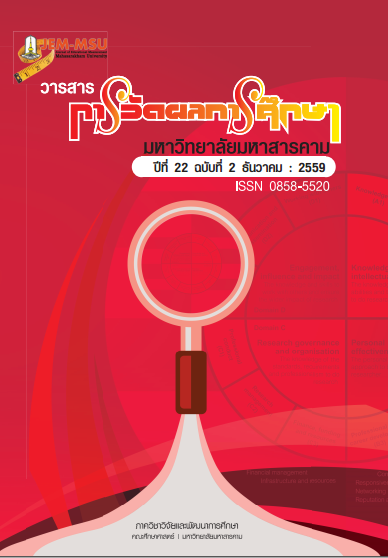The Comparison of Learning Achievements, Creative Thinking and Attitude in Computer of Matthayomsuksa 5 Students by Using Project Based Learning and Creative Problem Solving
Main Article Content
Abstract
The purposes of this research were: 1) to develop the learning activities using
project based learning and creative problem solving with the required efficiency of 75/75,
2) to study the effectiveness indices of the learning activity using project based learning and
creative problem solving on topic of “Creating Web Pages” of Matthayomsuksa 5 3) to compare
the learning achievement, creative thinking and attitude towards computer of Matthayomsuksa 5
before and after using project based learning 4) to compare the learning achievement,
creative thinking and attitude towards computer of Matthayomsuksa 5 before and after using
creative problem solving 5) to compare the learning achievement, creative thinking and
attitude towards computer of Matthayomsuksa 5 between project based learning and
creative problem solving. A sample were two classes of Matthayomsuksa 5 who studied in
first semester of academic year 2015 from Muaklekwittaya school under the supervision of
the Secondary Educational Service Area Office 4 and were selected by cluster random
sampling technique. The research instruments were: 1) the learning activity using the project
based learning plans and the learning activity using the creative problem solving plans, 8
plans each, taught for 16 hours 2) the 40 items of multiple choices of learning achievement
test with the range of discrimination value at 0.37 – 0.88 and reliability value at 0.86, 3) a
subjective 3 items of creative thinking test with the range of difficulty value at 0.67 – 0.71;
the range of discrimination value at 0.44 – 0.56 and reliability value at 0.89, 4) the 15 items
of rating scale of attitude toward computer learning activity with the range of discrimination
value at 0.43 – 0.71 and reliability value at 0.89. The statistics were used for analyzing the
collected data were mean, standard deviation, percentage and Hotelling's T2 for testing
research hypothesis. Research results revealed as the followings:
1. The effectiveness of developing activity using project based learning and creative
problem solving on the topic of “creating web pages” of Matthayomsuksa 5 was 79.38/77.83
and 80.48/78.23 respectively which was higher than the set standard of 75/75.
2. The effectiveness indices of the plans for learning by using project based
learning and creative problem solving on the topic of “creating web pages” Matthayomsuksa 5
were 0.6683 and 0.7005 respectively that meant students improve their achievement at
66.83% and 70.05% respectively.
3. The Matthayomsuksa 5 students’ achievement, creative thinking and attitude
towards computer after using project based learning was higher than before learning at 0.05
level of significance.
4. The Matthayomsuksa 5 students’ achievement, creative thinking and attitude
towards computer after using creative problem solving was higher than before learning at
0.05 level of significance.
5. The Matthayomsuksa 5 students’ achievement, creative thinking and attitude
towards computer who learned through the project based learning and creative problem
solving it was found that there was not a significant difference.
Article Details
The content and information contained in the published article in the Journal of Educational Measurement Mahasarakham University represent the opinions and responsibilities of the authors directly. The editorial board of the journal is not necessarily in agreement with or responsible for any of the content.
The articles, data, content, images, etc. that have been published in the Journal of Educational Measurement Mahasarakham University are copyrighted by the journal. If any individual or organization wishes to reproduce or perform any actions involving the entirety or any part of the content, they must obtain written permission from the Journal of Educational Measurement Mahasarakham University.


